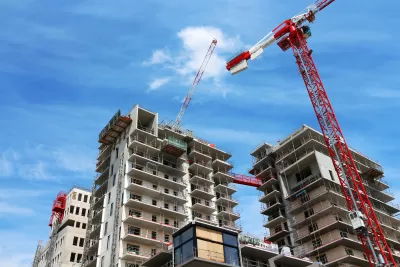Despite a strong belief in market forces in many other aspects of the economy, many Americans don’t see a correlation between housing supply and housing costs.

Writing in New York Magazine, Eric Levitz points out the odd breakdown of the “comprehension of the relationship between supply and affordability” when it comes to the way many Americans think about housing.
If the government tightly limited the production of sneakers, thereby triggering a bidding war over scarce athletic footwear, few would question whether the state’s deliberate suppression of shoe manufacturing was implicated in rising sneaker prices.
But “A 2022 study from political scientists in the University of California system found that a majority of Americans do not believe that increasing the supply of housing makes it more affordable.”
While it’s true that new housing sometimes appears to lead to higher rents, “the reason why new construction sometimes correlates with rising rents is not that housing is a good unlike any other, such that the more of it you create the more expensive it becomes,” Levitz explains.
“Rather, the reason is that developers build new housing in response to rising demand.” If local regulations or NIMBY opposition blocks needed new housing from being built, prices will go up. “Thus the less new housing that gets built, the faster rents will rise in a booming city”—see Austin, Texas for a recent example.
Levitz counters the “popular idea that new market-rate housing can’t reduce rents for working people because private developers prefer to build ‘luxury’ properties instead of affordable ones,” writing that the high cost of new housing is largely due to high land costs, and “new buildings will absorb high-income renters, reducing demand (and thus rental prices) for older housing units.”
Ultimately, “We can’t fully resolve our housing crisis by unshackling the invisible hand. But widespread skepticism about the relevance of ‘supply and demand’ to the housing market is making the crisis worse.”
FULL STORY: Rent Growth Is Slowing (Where Housing Got Built)

Study: Maui’s Plan to Convert Vacation Rentals to Long-Term Housing Could Cause Nearly $1 Billion Economic Loss
The plan would reduce visitor accommodation by 25,% resulting in 1,900 jobs lost.

North Texas Transit Leaders Tout Benefits of TOD for Growing Region
At a summit focused on transit-oriented development, policymakers discussed how North Texas’ expanded light rail system can serve as a tool for economic growth.

Why Should We Subsidize Public Transportation?
Many public transit agencies face financial stress due to rising costs, declining fare revenue, and declining subsidies. Transit advocates must provide a strong business case for increasing public transit funding.

How to Make US Trains Faster
Changes to boarding platforms and a switch to electric trains could improve U.S. passenger rail service without the added cost of high-speed rail.

Columbia’s Revitalized ‘Loop’ Is a Hub for Local Entrepreneurs
A focus on small businesses is helping a commercial corridor in Columbia, Missouri thrive.

Invasive Insect Threatens Minnesota’s Ash Forests
The Emerald Ash Borer is a rapidly spreading invasive pest threatening Minnesota’s ash trees, and homeowners are encouraged to plant diverse replacement species, avoid moving ash firewood, and monitor for signs of infestation.
Urban Design for Planners 1: Software Tools
This six-course series explores essential urban design concepts using open source software and equips planners with the tools they need to participate fully in the urban design process.
Planning for Universal Design
Learn the tools for implementing Universal Design in planning regulations.
City of Santa Clarita
Ascent Environmental
Institute for Housing and Urban Development Studies (IHS)
City of Grandview
Harvard GSD Executive Education
Toledo-Lucas County Plan Commissions
Salt Lake City
NYU Wagner Graduate School of Public Service





























